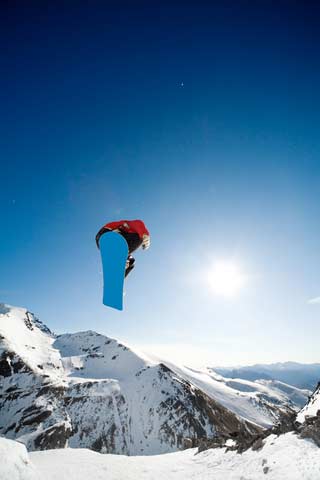Winter X Games Tricks: Are There Physical Limits?

At last year's Winter X Games, snowboarder Shaun White snatched the gold medal with a run which included the first 1260-degree spin (3-1/2 rotations) in X Games history (see video here). A few nights before, Levi LeValle won gold in the Snowmobile Freestyle with tricks that included a full backwards flip (watch it here).
As the snow daredevils arrive in Aspen this week for the 2009 version of Winter X, how will they take it to the next level? And is there a physics-based limit to their spins and flips? "It's a game of one-upmanship," Mike Jankowski, freestyle coach for the United States snowboard team, told The New York Times. "It's been this way for years and years in snowboarding." Performing last year's tricks just won't win the gold medal. Adding an extra half spin, grab or twist is required to end up on the podium. "Tricks are definitely being progressed almost on a daily basis," said Steve Fisher, who won gold in the Superpipe at the X Games in 2007.
Pushing physical limits Within the confines of the Superpipe, which literally looks like a giant pipe cut in half with groomed snow sides, the laws of acceleration, gravity and conservation of energy rule. As boarders drop in from the top, they start down one side of the pipe, accelerate through the bottom of the "U," and then ride up the other side. The faster they launch off of the top of the pipe, the more time in the air they have to pull off their tricks.
From a physics perspective, the height of the sidewalls, the boarder's weight and gravity determines the amount of gravitational potential energy available. On the way down, this potential energy converts to kinetic energy through the bottom of the pipe, and up the other side.
At launch, the total kinetic energy is available for two purposes: how high the rider will soar and how many spin rotations he tries to complete in the air. So, more spins mean less height and vice versa. Obviously, the Winter X Games organizers are fans of physics. For the first time, this year's sidewalls will be raised from 18 to 22 feet tall. The additional height will increase the downward acceleration, providing more speed and energy coming off the other side.
While last year's 1260 could become this year's 1440, (four full spins), some riders may choose to use the extra air to add style points and height with fewer spins. This trade-off decision between spins and style is a tough one.
"The hardest thing about this sport has always been to do a difficult trick and make it look smooth," Andreas Wiig, two-time X Games Slopestyle gold medalist, told ESPN. "At a certain point, we could reach a level where it might not make sense to go for the next big spin, just because it gets too hard to hold everything together."
Get the world’s most fascinating discoveries delivered straight to your inbox.
Theoretical limit For LeValle and the other snowmobilers, the progression to the next level most likely will be the double back flip. No one has pulled it off yet, but several have been practicing. Alaska's Dane Ferguson has been flipping dirt bikes into a foam pit in Southern California trying to simulate and learn the math behind landing a double. "My goal was to get a feel for the double back flip," Ferguson told ESPN in a recent interview. "I have a good idea of how much air and speed I need." Check out how he's doing here. One person they may want to call is James Riordon, physicist and head of media relations for the American Physical Society. He has applied the physics and math to determine the theoretical number of back flips for a motocross bike.
Despite the fact that no one has landed a double in freestyle motocross, Riordon has calculated that four back flips are mathematically reasonable. Since a motocross bike is about 80 percent the weight of a snowmobile, a triple back flip for the sleds may be possible.
Ferguson says he feels good about his attempt at the double this week in Aspen, "I am very confident that I can do it safely. I believe I know when to bail and all that." Dan Peterson writes about sports science at his site Sports Are 80 Percent Mental.
 Live Science Plus
Live Science Plus





